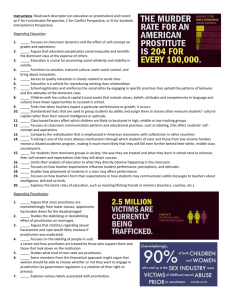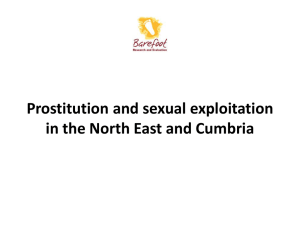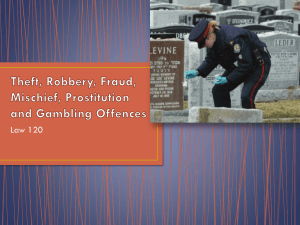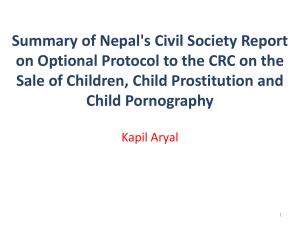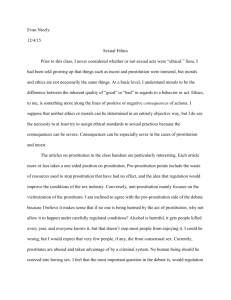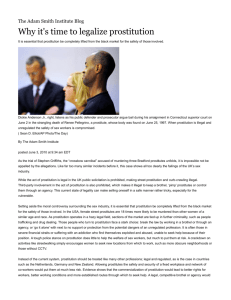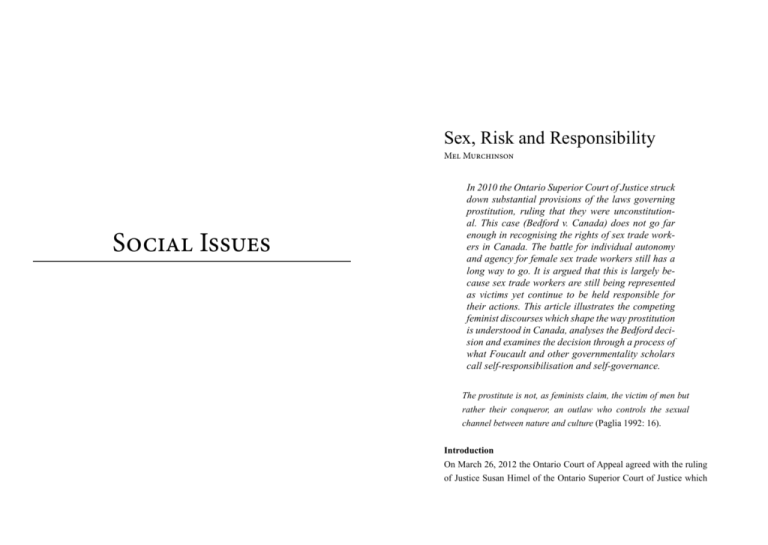
Sex, Risk and Responsibility
Mel Murchinson
Social Issues
In 2010 the Ontario Superior Court of Justice struck
down substantial provisions of the laws governing
prostitution, ruling that they were unconstitutional. This case (Bedford v. Canada) does not go far
enough in recognising the rights of sex trade workers in Canada. The battle for individual autonomy
and agency for female sex trade workers still has a
long way to go. It is argued that this is largely because sex trade workers are still being represented
as victims yet continue to be held responsible for
their actions. This article illustrates the competing
feminist discourses which shape the way prostitution
is understood in Canada, analyses the Bedford decision and examines the decision through a process of
what Foucault and other governmentality scholars
call self-responsibilisation and self-governance.
The prostitute is not, as feminists claim, the victim of men but
rather their conqueror, an outlaw who controls the sexual
channel between nature and culture (Paglia 1992: 16).
Introduction
On March 26, 2012 the Ontario Court of Appeal agreed with the ruling
of Justice Susan Himel of the Ontario Superior Court of Justice which
112
Mel Murchinson
Sex, Risk and Responsibility
struck down two key prostitution laws in Canada. After hearing arguments from three applicants, Justice Himel decided that sections 210,
212(1)(j) and 213(1)(c ) of the Criminal Code of Canada (prohibiting the
keeping of a common bawdy house, living off the avails of prostitution
and communicating for the purposes of prostitution respectively) violated their right to life, liberty and security of the person under section
seven of the Charter and could not be saved under section one,1 making
them unconstitutional and not in accordance with fundamental justice.2
While the act of prostitution itself has never been illegal in Canada these
provisions essentially criminalised all activity surrounding the act of
prostitution and thus made the act effectively illegal. This means that
sex trade workers3 are widely seen as victims, yet the government holds
them responsible for the outcomes of their work in neo-liberal Canadian
society through a process of what Foucault and other governmentality
scholars call self-responsibilisation and self-governance (Gordon 1991:
82).
the individualists and the structuralists)4 are antithetical to each other and
This article argues that while any step forward is to be celebrated, the
battle for individual autonomy and agency for female sex trade workers
still has a long way to go. This is largely because sex trade workers are
still being represented as victims yet continue to be held responsible for
their actions. This article illustrates the competing feminist discourses
which shape the way prostitution (sex trade work) is understood in Canada, and subsequently examines the decision through a process of what
Foucault and other governmentality scholars call self-responsibilisation
and self-governance. The two competing feminist viewpoints (held by
Opposing Feminist Discourses
In order to understand feminist views on sex trade work and the arguments for and against the decriminalization of sex trade work the two
main theoretical approaches within the feminist camp must be explored.
The structural feminists and the individualistic feminists could not be
more opposed, as they view this issue from completely different sides.
Sex work can be seen as creating a dichotomy in feminism and the two
main issues that arise between these camps are centred on the notion of
consent and coercion (Freeman 1989: 75).
1 Canadian Charter of Rights and Freedoms, Part 1 of the Constitution Act 1982, schedule B to the Canada Act 1982 (U.K.) c.11.
2 Bedford v. Canada, 2010 ONSC 4264, at para 3.
3 I acknowledge that while the vast majority of sex trade workers are female, there are
some men who work in the trade. However, due to the fact that the cases dealt with only
female prostitution and in order to adequately explain the feminist dichotomy I am choosing to focus only on female sex trade workers.
it is important to understand this dichotomy as it relates to framing of sex
trade workers in its current context. It will be argued that the Canadian
government is engaging in a process of risk management and responsibilisation in dealing with sex trade workers, which intentionally creates
a process in which these women are supposed to govern themselves. The
striking down of legislation may be seen as progress, perhaps as a first
step, or almost a victory for the individualist feminists. Sex trade workers are no longer being seen by the courts as helpless victims unable to
control their own fate, but as agents who are making a conscious choice
that needs to be respected. However, the problem lies in that all of the
governance and responsibilisation is now forced back on these women
and is not in the hands of the state. Instead of Parliament responding to
the judicial decision and implementing legislation to keep sex workers
safe, the state has essentially said ‘work at your own risk’, something
that would not be tolerated in any other industry.
a. Structural Feminism
4 Sometimes these feminist groups are referred to as liberal and radical feminists respectively, however these terms are used to ensure consistency.
113
114
Mel Murchinson
Structural feminists5 believe that all sex trade workers are victims of
coercion and are incapable of consenting to the lifestyle in which they
are living because of the inherently uneven power structure which leaves
these women vulnerable to this line of work (Angelovicova 2006: 3). To
the structuralists, there is no such thing as ‘consent’ because, in one way
or another, sex work is always coercive, whether it is a consequence of
extreme poverty, colonialism, victimization, patriarchy or class hierarchies (Sullivan 2000: 1). Structuralists compare sex work to modern day
slavery and believe that female sex workers are completely submissive
to men (Sullivan 2000: 1). From this viewpoint, sex workers do not have
any type of agency, as they are so oppressed and marginalized, regardless of whether they are consciously aware of it or not. This extends to
the supposed ‘choice’ of sex trade work to begin with: the structuralists
argue that no woman chooses to work in the sex trade, but rather that
they are coerced and forced to do so, and that sex trade work only serves
to further objectify and subordinate women (Freeman 1989: 75). Prostitution is a form of slavery because “the prostitute cannot sell sexual
services alone; what she sells is her body”, and the
…representation of prostitution as a ‘free contract’ is simply
another example of how women’s sexual submission is confused with consent and free association. Prostitution is unilateral subjection to sexual acts with the consolation of payment
(Sullivan 2000: 2).
Most structural feminists are abolitionists who believe that all sex work
should be eradicated and harsher criminal sanctions applied to all who
benefit from sex; with the exception of criminalizing the sex worker her-
5 Examples of structural feminism can be seen in the work of Catherine McKinnon,
Andrea Dworkin, Kathleen Barry and Jane Freeman.
Sex, Risk and Responsibility
self. Such laws currently exist in Finland, Norway and Sweden6 and are
supported by structuralists (Outshoom 2004: 9). Structuralists even go
so far as to reject the terms ‘sex-work’ or ‘sex worker’ as they believe
these discount women as victims in this supposed ‘industry’. According
to Janice Raymond, structuralists argue:
If women in prostitution are counted as workers, pimps as
businessmen, and buyers as customers then governments can
abdicate responsibility for making sustainable employment
available to women (Angelovicova 2006: 4).
Problems with the structuralist view arise because it almost entirely negates women’s ability for individual self-determination. Instead of viewing these women as agents capable of choice, structuralists act in a paternalistic manner, believing that these women are so oppressed they cannot
consent to any type of behaviour. This view demeans women in the sex
trade who maintain that they choose and enjoy working in this industry
and revictimises them, by stating or implying that they are in fact being
degraded (Halley 2006: 351).
b. Individualist Feminism
In contrast, the individualist feminists believe that sex trade workers are
engaging in a consensual, legal work activity to earn an income and are
making this decision based on freedom of individual choice. This view
is perhaps best explained by Ericsson who argues:
If two adults voluntarily consent to an economic arrangement
concerning sexual activity and this activity takes place in private, it seems plainly absurd to maintain that there is some6 See Sweden’s Sex Purchase Act, 1999, part of Kvinnofrid (Violence against Women
Act); Section 202a of the Norwegian Penal Code; and Finland’s Sexköpslag (Sex Purchase Act).
115
116
Mel Murchinson
Sex, Risk and Responsibility
thing intrinsically wrong with it… that is prostitutes [are] no
more economically exploited than wage workers in general
(1980: 339-340).
Individualists support models of legalisation and regulation that exist in
other jurisdictions such as the Netherlands, Nevada, New Zealand and
parts of Australia (Halley et al 2006: 399).
From this viewpoint the individual autonomy of all persons involved is
paramount: all persons involved in the sex trade enter into a contractual
business agreement and no woman is ‘forced’ into the sex trade more
than into any other profession that is dominated by females such as secretarial work or child rearing (Peterson-Iyer 1998: 25-26). As one Canadian prostitute illustrates in Peterson-Iyer’s article:
The problem with both of these feminist viewpoints is that because
they are so diametrically opposed they fail to acknowledge the middle
ground. Although both perspectives do represent some of the women in
Let’s stop the victim shit.... Let’s recognize that we’re not crippled as women in this industry. We are capable of exercising
healthy control over our own environment (1998: 25).
The goal for individualist feminists is the decriminalization of all aspects
of sex work and the normalization of sex work through legislation, usually requiring the implementation of new laws to guarantee sex workers
rights and safety (Outshoorn 2004: 9). There are also several prostitution
rights groups that lobby for decriminalization of all aspects of prostitution, regulation and safer environments provided by legally sanctioned
brothels in both America and Canada. Such groups include ‘Call off
Your Old Tired Ethics’, the ‘National Task Force on Prostitution’ and
the ‘International Committee for Prostitutes Rights’ (Peterson-Iyer 1998:
24). These organizations make a very important distinction between voluntary sex work (engaged in by adults as a form of employment) and
forced sex work (which can include children, human trafficking and or
sex trafficking) (Peterson-Iyer 1998: 24). They advocate the decriminalisation and legalization of voluntary sex work, but not forced sex work
(Peterson-Iyer 1998: 24). Individualist feminists defend the freedom to
work, the right to self-expression of sex trade workers, and perhaps most
importantly, the right to consent to sex for pay (Angelovicova 2006: 4).
the sex trade it is problematic that both feminist camps tend to view these
women as groups belonging to categories. Instead of looking at sex trade
workers as individuals on a continuum, from victim to agent, or coerced
to consenter and everywhere in between each camp takes an all or nothing approach and argues that every sex trade worker falls into their camp.
In the jurisdictions where prostitution and the surrounding acts are legal, such as Nevada and Holland, regular health checks are required,
precautions against sexually transmitted infections are taken, employers and brothel owners are screened for criminal records and have to
be licensed, sex workers are registered and the sex workers pay taxes
on their earnings (Peterson-Iyer 1998: 20; Feminists for Choice 2011).
This is a harm reduction approach which would not be difficult to implement in Canada. Justice Himel read several research articles and heard
expert testimony herself in reviewing the more than 25,000 pages of evidence submitted by the parties citing a variety of sources including former prostitutes, politicians, lawyers, researchers and social workers and
other experts in the field.7 Himel paid particular attention to the change
in the criminalisation and subsequent legalisation in several countries
including Sweden, Nevada (United States), Australia, New Zealand and
The Netherlands.8
Prostitution is legal and regulated in twenty-three countries and not only
7 Bedford v. Canada, 2010 ONSC 4264 at para 84.
8 Bedford v. Canada, 2010 ONSC 4264 at para 84.
117
118
Mel Murchinson
does this decrease harm to the individual sex workers, but also to the surrounding communities by having the sex workers healthy, contributing
to society, and for the most part, off the streets (Peterson-Iyer 1998: 20).
According to Shannon, the:
…enforcement of criminal sanctions targeting sex work…displaces sex workers to isolated alleys and industrial settings
away from health and support services. Enforced displacement and lack of access to safer indoor work environments
independently increase sex workers’ risk of physical violence
and rape, and reduces their ability to safely negotiate condom
use with clients thereby protecting themselves from sexually
transmitted infections and unwanted pregnancies. Qualitative evidence further describes how criminal sanctions limiting sex workers’ ability to regulate safer industry practices
(e.g., create unions, safer indoor work spaces. etc.) compound
health-related risks (2010: 1388).
Sex, Risk and Responsibility
Foucault’s theory of governmentality is that “we are ‘governed’ through
and by means of our ‘freedom’” (Rose 1999: 62) and that this has the
effect of producing ‘free persons’ or people who perceive themselves
to be free (Garland 1997: 196). This is consistent with Foucault’s view
of governmentality and neoliberalism, or the idea that individuals are
regulated from the inside. In Foucaultian theory self-regulation occurs
when power is de-centred and individuals have to take responsibility for
their own welfare and play a large role in their own responsibilisation
(Garland 1997: 197).
In order to fully explore sex work in context, as it exists in a neoliberal
framework, this paper now turns to Michel Foucault to begin illustrating
the concepts of self-governance and self-responsibilisation.
Venn defines Foucault’s version of neoliberal governmentality as “a kind
of governmentality based on the predominance of market mechanisms
and of the restriction of the action of the state; the knowledge produced
allows the construction of auto-regulated or auto-correcting selves”
(Venn 2010). When it comes to prostitution the neo-liberal agenda, “bifurcates control by offering social inclusion to those who responsibly
exit and ‘resume’ normal lifestyles” (Scoular and O’Neill 2007: 764).
It results in the continued exclusion of those who remain involved or
choose to be involved in street sex work; they are constructed and reproduced in law as anti-social, and are ‘othered’ (Scoular and O’Neill
2007: 765).
Foucault, Neoliberalism and Sex Trade Work
Foucault’s ‘governmentality’ approach (government-mentality or government rationality) discusses the way that citizens are subject to rule,
initially through a monarch and later through state and non-state systems
of government. He argues that governmentality is in a ‘broad sense about
the techniques and procedures for directing human behaviour… government of a state or one’s self’ (Burchell, Gordon & Miller 1991: 82). In
late-modern societies such as Canada, the ‘state’ has changed in terms
of both its construction and the way in which it governs and controls
subjects (Scoular and O’Neill 2007: 766). One of the central claims of
There are numerous key characteristics of a neoliberal governmentality
approach: the first is that the “management of specific populations is no
longer assumed to be located within the state” (Lippert & Park in Kramar
2010: 5) and that expertise should be purchased by each individual acting carefully and sensibly (Lippert & Park in Kramar 2010: 6). This has
the effect of essentially decriminalising most aspects of sex work which
has been seen with the two decisions in Bedford. Despite the courts putting a stay on their rulings for one year the state has not responded with
any political action to regulate this industry and ensure safety or start a
process of harm reduction. Instead it has adopted a ‘hands off’ approach
119
120
Mel Murchinson
by telling sex workers that it will not intervene or help them in any way
as they have adopted the responsibility for their own industry. This has
had the effect of shifting the responsibility for the risky conditions of
sex trade work from the state to the private market, in this case the sex
workers and their clients, which allows the state to engage in a process
of ‘risk management’ (Lippert & Park in Kramar 2010: 6). By doing so
the state is free to abdicate its responsibility to provide safe working
conditions and social safety nets such as pensions, retirement funds, and
basic labour rights. This is something that would be unthinkable in any
other line of work.
Hannah-Moffatt argues that the management of risk by the state incorporates both moral and political components which are thereby passed
down onto its citizens (Hannah-Moffat 1999). In terms of sex work reform, the (im)morality of the sex trade industry is tied in with the political decision making capabilities of the state. The state still perceives sex
work to be primarily an immoral, mostly legal act, and therefore shies
away from regulating and governing it due to the political risk of doing
so. In this way the collective risk of the entire sex trade industry is no
longer seen as the state’s responsibility, nor that of the community, but
now is solely borne by the individual sex trade worker.
The second important characteristic of this approach is that responsibility shifts to more local levels. This is seen by an increasing emphasis
on the ‘community’ which displaces the social as the governing field
(Lippert & Park 2010: 6). In relation to sex trade work, the state’s goal
of ‘protecting victims and communities’ allows the state to remove itself
from any role in the process of social exclusion of women who sell sex
while extending its control over subjects. In so doing, it represents itself
as not only the protector of the community and family values but also
lets the community demonize and exclude sex trade workers without
being seen as causing the discord. Hence, “the state’s role in structural
Sex, Risk and Responsibility
exclusion and in perpetuating norms of the sex industry is thus masked
by the progressive (neoliberal) governance of sex work” (Lippert & Park
2010: 6). In this sense, the community takes on the responsibility of
moral judgements of risk and deciding which actors and activities need
governance.
The third and perhaps most important characteristic of neoliberal governmentality is the notion of ‘empowerment’ (Scoular and O’Neill 2007:
769). This supposes that individuals, seen as “subjects of responsibility,
autonomy and choice” are more active in their own governance (Hannah-Moffat 2001: 163). The responsible citizen is one who self-governs
and attempts to increase their productivity and capacity for understanding while minimizing their risk exposure (Hannah-Moffat 1999). In this
way, by constructing the women involved in the sex trade as high risk
subjects rather than recognizing them as perceptive subjects who manage risks, it is easier to continue to marginalize their behaviour (Scoular
and O’Neill 2007: 770). Contemporary forms of governance are able
to operate through responsibilisation techniques, whereby the individual
sex worker is supposed to do one of two things. She can either recognize
the industry she is in as dangerous, and subsequently find other means
of employment; or, take all of the responsibility for the work she engages in and enter into the line of work fully aware that the state has no
mechanisms in place to reduce her harm and as such, will not protect her
(Scoular and O’Neill 2007: 770).
Conclusion
This article has discussed the neoliberal self-governing strategy of self
responsibilisation that is currently in place with regard to sex trade workers in Canada, and has examined the two competing feminist discourses
which shape the way sex trade work is understood there. These viewpoints (the individualists and the structuralists) are antithetical to each
other and it is important to understand the dichotomy as it relates to the
121
122
Mel Murchinson
framing of sex trade workers particularly when considering the enactment of new legislation. More problems with the current state of the
sex trade industry lie in that all of the governance and responsibilisation
of the profession is now forced back on these individual women as sex
trade workers, and not where it should be, which according to the courts,
is in the hands of the state. Instead of Parliament implementing legislation to keep sex workers safe the state has essentially told all sex trade
workers in Canada that they can work at their own risk: this would not
be tolerated in any other industry. According to the Bedford decision it is
of pivotal importance that citizens recognize that sex trade workers are
women earning a legal income through legitimate means and that they
deserve to be treated with the same level of respect as any other income
earner. It is the role of Parliament to respond to the court’s decision. Parliament’s silence means that sex trade workers have had to self responsibilise and self-govern; a role that they should not have had to undertake.
It is time now in the light of two affirmative rulings on prostitution that
legislation be passed to protect sex workers and allow them the agency
and autonomy afforded to all other working individuals.
Sex, Risk and Responsibility
Bibliography
Angelovicova, A. (2006) Trafficking in Women. Grin Verlag: Germany.
Bedford v. Canada (Attorney General), 2010 ONCA 814.
Bedford v. Canada, 2010 ONSC 4264.
Burchell, G., Gordon, C., & Miller, P. (Eds.) (1991) The Foucault Effect: Studies
in Governmentality. Chicago: The University of Chicago Press.
Canadian Charter of Rights and Freedoms, Part 1 of the Constitution Act, 1982,
Schedule B to the Canada Act 1982 (U.K) c.11.
Canadian Criminal Code, R. S. C. 1985, c. C-46.
Ericsson, L. O. (1980) ‘Charges Against Prostitution: An Attempt at Philosophical Assessment’, Ethics. Vol. 90: 338-339.
Feminists for Choice (2011) ‘Holland to start taxing prostitutes’. Available at
http://feministsforchoice.com/holland-start-taxing-prostitutes.htm (Accessed:
October 2012).
Foucault, M. (1977) ‘Governmentality’, in Burchell, G., Gordon C., and Miller,
P. (eds) (1991), The Foucault Effect: Studies in Governmentality, Chicago: University of Chicago Press.
Freeman, J. (1989) ‘The Feminist Debate over Prostitution Reform: Prostitutes’
Rights Groups, Radical Feminists, and the (Im)possibility of Consent’ Berkeley
Women’s Law Journal. Vol. 5(1): 75-169,
Garland, G. (1997) ‘‘Governmentality’ and the Problem of Crime: Foucault,
Criminology, Sociology’ Theoretical Criminology. Vol. 1(2): 173-214.
Halley, J. (2006) ‘From the International to the Local in Feminist Legal Responses to Rape,
Prostitution/Sex Work, and Sex Trafficking: Four Studies in Contemporary Governance Feminism’ Harvard Journal of Law and Gender. Vol. 29: 335.
123
124
Mel Murchinson
Hannah-Moffat, K. (1999) ‘Moral Agent or Actuarial Subject: Risk and Canadian Women’s Imprisonment’ Theoretical Criminology. Vol. 3(1): 74-91.
Hannah-Moffat, K. (2001) Punishment in Disguise: Penal Government and Federal Imprisonment of Women in Canada. Toronto: Toronto University Press.
Lippert, R. & Park, G. (2010) ‘Governance and Criminology’, in Kramar, K.
(ed.) Criminology: Critical Canadian Perspectives. Toronto: Pearson.
Outshoorn, J. (2004) The Politics of Prostitution: Women’s Movements, Democratic States, and the Globalization of Sex Commerce. Cambridge: Cambridge
University Press.
Paglia, C. (1992) Sex, Art, and American Culture: Essays. Vintage.
Peterson-Iyer, K. (1998) ‘Prostitution: A Feminist Ethical Analysis’ Journal of
Feminist Studies in Religion. Vol. 14(2): 19-44.
Prostitution Reference re ss. 193 and 195.1(1) of the Criminal Code (Man.),
[1990] 1 S.C.R. 1123.
Rose, N. (1999) Powers of Freedom: Reframing Political Thought. Cambridge:
Cambridge University Press.
Scoular, J. and O’Neill, M. (2007) ‘Regulating Prostitution: Social Inclusion,
Responsibilisation and the Politics of Prostitution Reform’ British Journal of
Criminology. Vol. 47: 764-778.
Shannon, K. (2010) ‘The hypocrisy of Canada’s prostitution legislation’ Canadian Medical Association Journal. Vol. 182(12): 1388.
Sullivan, B. (2000) ‘Rethinking Prostitution and ‘Consent’’, in Castles, F. and
Uhr, J., Proceedings of the 2000 Conference of the Austral-Asian Political Studies Association, Australian National University, Canberra, (1-7), 3-6 October,
2000.
Venn. C. (2010) ‘Foucault’s analysis of neo-liberalism: Implications for the
present’, Theory Culture and Society. Available at http://www.sagepub.net/tcs/
default.aspx?page=couzeneolib (Accessed October 10, 2012).



